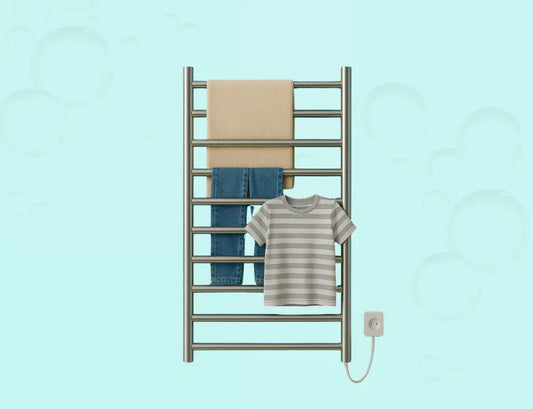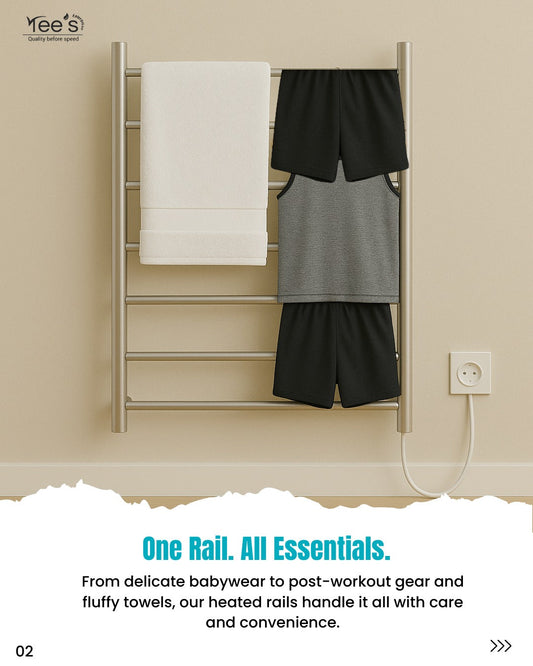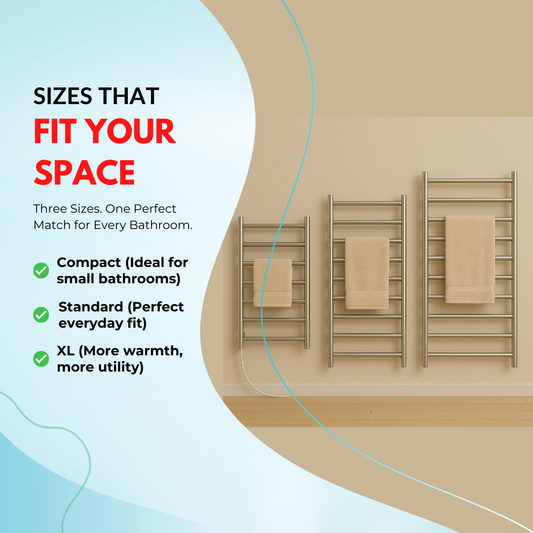Electric Clothes Drying Racks vs Traditional Methods – Best Choice for Indian Homes

The Limitations of Traditional Drying Methods in India
Traditional drying methods like ropes, clotheslines, and basic foldable racks have served Indian households for decades. But they come with some clear limitations:
-
Weather dependency – No sun means no drying, especially during monsoons or foggy winters.
-
Space usage – Balconies and terraces are often cluttered with drying laundry, leaving little room for movement.
-
Aesthetic impact – Wet clothes hanging all over the house can ruin the look of your interiors.
-
Slow drying time – On humid or cold days, clothes can take 24–48 hours to dry.
-
Odor and hygiene issues – Prolonged moisture can lead to musty smells and bacterial growth.
In growing urban areas where flats are compact and outdoor space is limited, these challenges make traditional methods inefficient and inconvenient.
What Is an Electric Drying Rack?
An electric drying rack India model is a modern indoor appliance designed to dry clothes faster and more efficiently. It uses low-level heat (in heated models) or improved airflow (in non-heated models) to speed up the drying process.
These racks are:
-
Lightweight and foldable
-
Plug-and-play
-
Energy-efficient
-
Safe for indoor use
-
Available in both heated and non-heated variants
Whether you’re looking to avoid musty clothes in the monsoon or dry woolens during winter, electric racks offer a practical solution.
Heated vs Non-Heated Clothes Rack – Key Differences
Let’s take a closer look at the heated vs non-heated clothes rack comparison:
| Feature | Heated Clothes Rack | Non-Heated Clothes Rack |
|---|---|---|
| Drying Speed | 2–5 hours | 5–10 hours |
| Power Usage | 100–200W per hour | None |
| Weather Independent | Yes | Partially (depends on airflow) |
| Fabric Safety | Gentle low heat | No risk of overheating |
| Portability | Foldable and mobile | Same |
| Best For | Monsoon & winter | Summer & well-ventilated homes |
Benefits of Using an Electric Drying Rack in India
1. Faster Drying Time
An electric drying rack India system, especially the heated type, dramatically reduces drying time. Lightweight clothes like t-shirts and towels dry within a few hours, even on rainy days.
2. Indoor Use Anytime, Anywhere
No need to rely on sunlight or outdoor space. These racks can be used in bedrooms, bathrooms, or utility corners, regardless of weather.
3. Space-Saving Design
Most electric drying racks are foldable and sleek, making them ideal for small apartments or shared accommodations.
4. Odor Prevention
Quick drying reduces the chance of bacterial growth or musty smells—a common issue in traditional indoor drying setups.
5. Gentle on Clothes
Unlike tumble dryers, electric racks dry clothes without harsh spinning or extreme heat, preserving fabric quality.
👉 Want to see how real Indian homes are using heated clothes rails? Follow us on Instagram for tips, photos, and real-user stories – https://www.instagram.com/teesenterprise/
When Should You Use a Heated Clothes Rack?
A heated drying rack is most useful during:
-
Monsoon season – When humidity makes air drying almost impossible.
-
Winter months – Especially in North India, where cold temperatures prevent quick evaporation.
-
Emergency drying – For uniforms, innerwear, or last-minute laundry needs.
-
Small apartments – Where air circulation is poor or space is limited.
Traditional Drying Is Still Useful, But Less Reliable
While electric racks are innovative, traditional drying methods still hold some advantages in specific scenarios:
-
Cost – No electricity bills, ideal for families on a tight budget.
-
Summer season – In dry, hot regions, natural sunlight remains the fastest dryer.
-
Zero setup – No installation or plug needed.
However, when convenience, speed, and hygiene matter—especially in cities—electric racks outperform in every category.
Tees Enterprise – Your Go-To for Electric Drying Rack India Solutions
At Tees Enterprise, we specialize in premium, energy-efficient electric drying rack India options that work seamlessly in modern Indian homes.
Our racks are:
-
Available in heated and non-heated variants
-
Designed for compact urban living
-
Durable, lightweight, and easy to store
-
Safe for all fabric types
-
Ideal for monsoons, winters, or daily indoor drying
Whether you’re drying baby clothes, office wear, or daily laundry, we have a solution tailored for your space and budget.
Final Verdict – Which Is More Efficient?
If you're comparing heated vs non-heated clothes rack options or deciding whether to stick with traditional drying methods, here’s a simple summary:
-
Efficiency: Heated electric racks are the fastest, especially in adverse weather.
-
Cost: Non-heated or traditional racks are budget-friendly but slower.
-
Convenience: Electric racks offer plug-and-play ease, year-round usability, and better hygiene.
-
Space: Foldable electric racks are ideal for tight living spaces.
For Indian homes facing seasonal challenges and space constraints, an electric drying rack is the smarter, more efficient solution.
FAQs About Electric Clothes Drying in India
Q1. What is the difference between a heated and non-heated electric drying rack?
Heated racks use electricity to generate warmth and dry clothes faster, while non-heated racks rely on improved airflow or design without any heat.
Q2. Is an electric drying rack safe for everyday use?
Yes, most models are designed with safety features like low-heat operation, stable frames, and auto shut-off timers.
Q3. How much electricity does a heated drying rack consume?
Typically between 100–200 watts per hour, which is much less than a traditional dryer or room heater.
Q4. Can I use electric drying racks for all types of clothes?
Yes, including woollens, cottons, innerwear, and delicate fabrics—without damage.
Q5. Are electric drying racks suitable for apartments?
Absolutely. Their compact and foldable designs make them perfect for Indian flats with limited space.
Q6. Where can I buy an electric drying rack in India?
You can explore reliable, affordable, and stylish options at teesenterprise.in.
Q7. Do I need a heated rack or will a non-heated version be enough?
If you live in a dry, sunny region, a non-heated rack might suffice. But for monsoon or winter use, a heated version is more reliable and time-saving.




